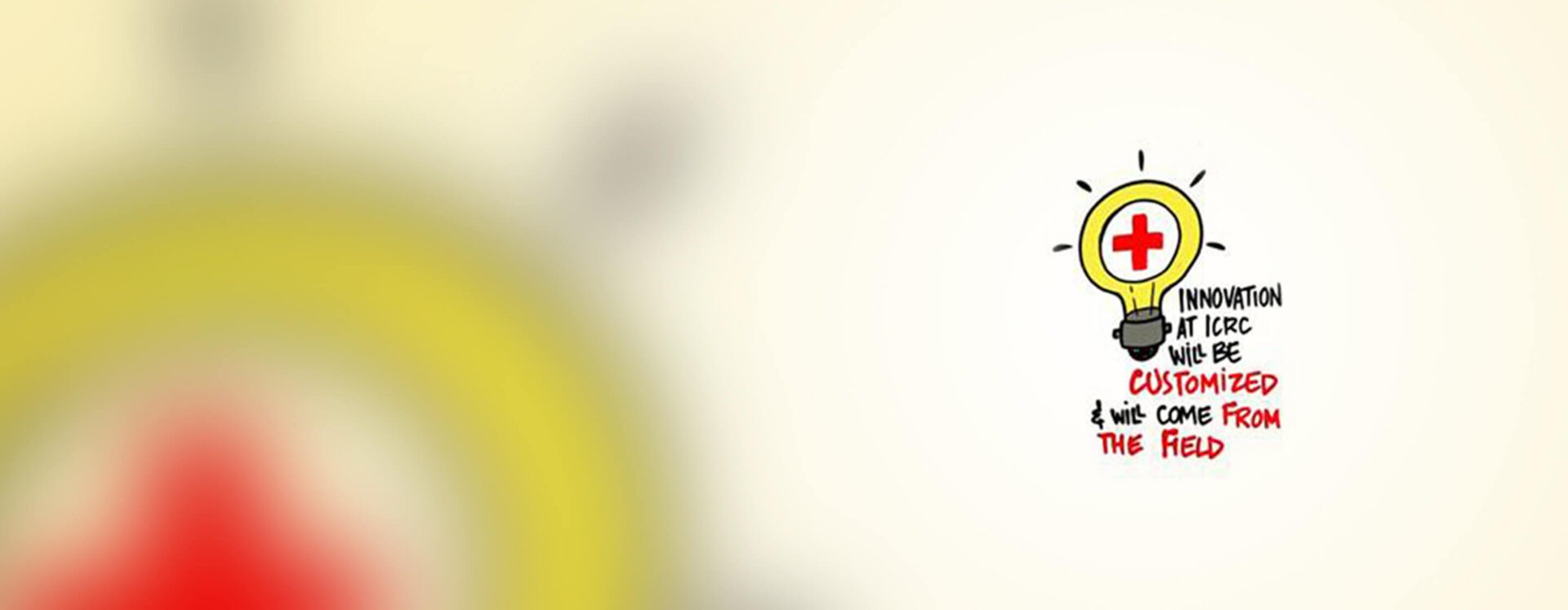
Global partnerships for humanitarian
impact and innovation (2): Challenges and
opportunities
90 leaders from the private sector, academia, research institutes and humanitarian organizations participated in an event at IMD that launched the Global Partnerships for Humanitarian Impact and Innovation (GPHI2) initiative. The event was the first in a series of initiatives on specific themes that will be held in 2015 to foster in-depth discussions and support concrete outcomes. This will be accompanied by the launch of tools, such as an ICRC ideation platform, to facilitate the cocreation and testing of new solutions. Stay informed by following the GPHI2 blog.
The Global Partnerships for Humanitarian Impact and Innovation (GPHI2) – an initiative by the International Committee of the Red Cross (ICRC) with support from Fondation Lombard Odier and IMD – aims to promote the development of innovative solutions to humanitarian challenges by harnessing the creative capacity of the private and the humanitarian sectors to respond to the needs of conflict victims. This ambitious initiative was launched at an event hosted by IMD in Lausanne that included representatives from the private sector, academia, research institutes, and leading humanitarian actors from the Red Cross and Red Crescent Movement and beyond. In this insights@ IMD we summarize the event and explore the challenges and opportunities of innovative humanitarian partnerships.
Challenges and priority issues
The ICRC has a tradition of working with the private sector, governments and other partners to develop innovative ways to help alleviate the suffering of people affected by conflict and violence (see text box). Examples of humanitarian innovation have ranged from building better carriages to transport wounded soldiers in the 19th century to modern advances in war surgery and the use of digital communications for humanitarian work. The changing global context has given rise to new challenges and priority issues, some of which guided the working group discussions during the event. These topics, which are examined in the following section, were selected with a view to focusing the debate and creating momentum around key strategic challenges facing
the ICRC and the humanitarian sector.
Challenge 1: Meaningful humanitarian action in the face of limited access
Maintaining the ability to work in close proximity to populations affected by
conflict is a growing challenge facing the ICRC and other humanitarian organizations. This working group session, moderated by Professor Maury Peiperl, focused on understanding the broader implications of deteriorating access for humanitarian action. During the discussion, a number of dualities emerged that are related to this issue: the aid vs. information duality – information can be aid and the two are more interconnected than ever; the remoteness vs. directness duality – solutions enabling direct access are required in parallel with solutions facilitating remote access to ensure effective humanitarian interventions; and the access vs. trust duality – the ability to get access, and to win or lose trust, is happening faster because of technology.
Challenge 2: Beneficiary engagement in a hyper-connected world
New technologies and regulatory developments present both challenges and opportunities for the ICRC, in terms of how it interacts with beneficiaries, gathers and shares information and protects data, as well as with regard to its ability to analyze “big data” to strengthen its response to humanitarian needs. Moderated by broadcaster Nik Gowing, this working group focused on determining how hyper-connectedness is expected to impact humanitarian work. One point that emerged is that the ICRC and other humanitarian actors are constantly reacting to rapidly changing external environments and are not proactively setting the agenda. This leaves them open to disruption of the public information space in disaster or conflict zones by actors who might not be sympathetic to humanitarian interventions. Another key issue concerns data – in an age of information overload, how can humanitarian organizations find new patterns in how to use data, and how much should they engage with others who are working with big data?
The implications for change management in a hyper-connected world were discussed in a follow-up session. The need to be inclusive and transparent, both internally with staff and externally with other stakeholders, emerged as a critical challenge related to perceived legitimacy in a hyper-connected world.
Challenge 3: Meeting the needs of conflict victims with frugal innovation
Rather than looking at adapting existing technologies to the needs of users in developing markets, these needs are now the starting point of the innovation process, leading to the development of a new kind of innovation. The working group dedicated to this challenge, moderated by Professor Charles Dhanaraj, discussed how “frugal innovations” – products and services that are aimed at contexts characterized by scarcity of capital, personnel and infrastructure – can allow humanitarian actors to better respond to beneficiaries’ needs. The discussion crystallized around a number of questions posed by the group: In which areas is the ICRC looking for innovation (see text box)? How does the organization adopt and diffuse an innovation? How does it get beneficiaries to buy in and adopt? Given the contextual difficulties in conflict zones, how does the ICRC engage stakeholders? How does it identify and disseminate problems to be solved to other potential innovators? What are the tools for frugal innovation? And how can the private sector benefit from the insights that the ICRC generates?
How frugal innovations are implemented was the focus of a follow-up working session. One key consideration is to identify the problem or the job to be done rather than prescribing the solution. Having a structured framework or system to do this, as well as an incentive system, can push forward innovations both inside and outside the organization. In addition, it is essential to talk to anyone interested in solving social problems – social entrepreneurs, technology startups, local communities and non-traditional participants – to tease out other ideas and allow for unexpected partnerships to form.
Priority issue 1: Defining and testing new partnership paradigms
The ICRC has traditionally taken a conservative approach to partnerships beyond the Red Cross and Red Crescent Movement, and there are numerous options that have yet to be tested by the institution, particularly with regard to partnerships with the private sector. Moderated by Professor Daina Mazutis, this working group aimed to broaden the conventional notion of partnership and explore new forms of potential collaboration with partners from the private sector. One theme that emerged was that if the ICRC wants to be regarded as a leading humanitarian organization in its relations with the private sector, then it needs to have a portfolio of strategic partnerships focused on specific ideas, tangible results and key performance indicators (KPIs) that can be widely shared and communicated. This would involve a review of the organization’s value chain from top to bottom to understand where partnerships are most needed. It would also involve looking for strategic alignment with potential partners and creating a business case with mutually supportive outcomes for all stakeholders.
Priority issue 2: Joining forces to meet the needs of people with physical disabilities
The ICRC is a leading actor in the field of physical rehabilitation in conflict and post-conflict countries. The Physical Rehabilitation Program (PRP) and its sister program the Special Fund for the Disabled (SFD) have been identified as one of the top areas for growth in the ICRC’s 2015-2018 strategy. This working group, moderated by Pascal Hundt, Head of the ICRC’s Assistance Division, focused on highlighting the challenges and potential solutions for the PRP & SFD programs and exploring how new forms of collaboration could be used to further broaden their impact. A key concern is attracting enough financing for these potential solutions. Innovative financing instruments, such as results-based financing and development impact bonds, could allow the organization to introduce new products and expand into new markets.
Opportunities
Despite these challenges, there remains a significant opportunity for innovative humanitarian partnerships (see insights@ imd #44). Yves Daccord, Director-General of the ICRC, noted that the ICRC has long been aware that partnerships between humanitarians, businesses, philanthropists and governments are critical for saving lives, and that these partnerships are more important than ever if creative solutions to the problems facing humanitarian organizations are to be found. Peter Maurer, President of the ICRC, stated that there is no question that partnerships with the private sector are of critical importance and affirmed the organization’s commitment to seeking innovative partnerships to tackle the world’s most intractable challenges.
Research Information & Knowledge Hub for additional information on IMD publications

Stay ahead in a shifting global economy. Learn how to build resilient supply chains, manage currency risks, and adapt strategies for long-term business success.

#post_excerptHannele Jakosuo-Jansson of Neste and Finnair shared key insights on board roles in CEO transitions and culture shifts with IMD’s High Performance Boards program.

An intelligent organizational sensory system detects, processes, and acts on change signals, giving your company a strong competitive edge.

Three Ways to Deal with Your Boss when they act against civility, empathy, and ethics. Discover strategies to handle difficult workplace dynamics effectively.

Six ways leaders can shape corporate reputation building strategies within their organizations, drawing on key insights from a Bloomberg Media study.

To navigate a turbulent business environment, CEOs must understand their landscape and align leadership thinking priorities, advises IMD’s Michael Watkins.
Case B describes the unprecedented challenges faced by CO-RO in 2020. The implementation of the sugar tax in its largest Middle Eastern market led to a near 50% volume drop in CO-RO’s sales, and Covid-19 lockdowns impacted the Asia-Pacific (APAC) ...
The CO-RO Group is a manufacturer of fruit-based still drinks, concentrates and ambient ice (home-freeze popsicles) headquartered in Denmark. Although production takes place in Denmark, most of its products are sold internationally, with the compa...
The case explores TBC Bank Group’s remarkable journey from a small Georgian bank to a regional leader in digital financial services across Central Asia. Founded in 1992 with just US$500 in initial capital, TBC evolved into Georgia’s largest financ...
The board of Nestlé S.A. announced that Anna Mohl would become the CEO of Nestlé Health Science (NHSc) — a global leader in nutritional science — on 1 January 2024. She was delighted to hear about her new position but knew there was little time to...
Research Information & Knowledge Hub for additional information on IMD publications
Research Information & Knowledge Hub for additional information on IMD publications
Research Information & Knowledge Hub for additional information on IMD publications
Research Information & Knowledge Hub for additional information on IMD publications
in I by IMD
Research Information & Knowledge Hub for additional information on IMD publications
Research Information & Knowledge Hub for additional information on IMD publications
Research Information & Knowledge Hub for additional information on IMD publications
Research Information & Knowledge Hub for additional information on IMD publications
Research Information & Knowledge Hub for additional information on IMD publications
Case reference: IMD-7-2636 ©2025
Research Information & Knowledge Hub for additional information on IMD publications

